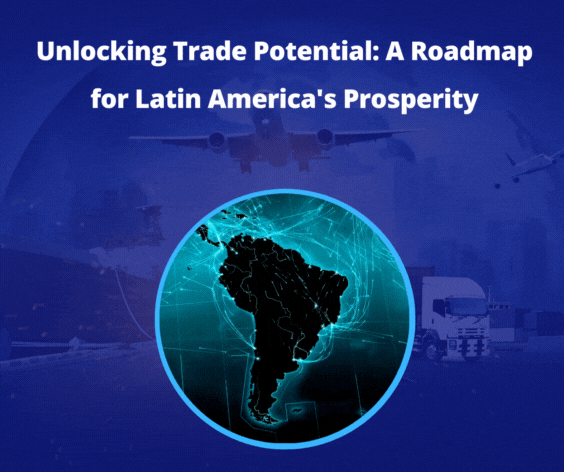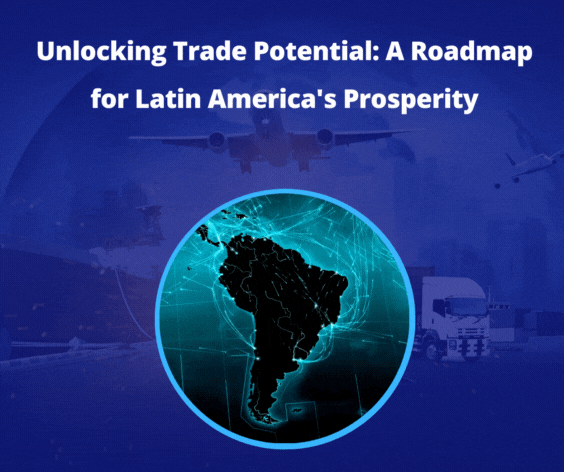
New Insights for Business
Introduction
Latin America stands at a pivotal moment in leveraging international trade to accelerate regional economic growth. Despite possessing vast potential due to its diverse markets and abundant natural resources, the region grapples with challenges that stifle its trade capabilities. Improved infrastructure and logistics could catalyze substantial growth, making the effective harnessing of global and regional trade a critical avenue for economic expansion.
Challenges Hindering Trade in Latin America
Infrastructure Deficiencies
Inadequate infrastructure is one of the most significant barriers to boosting trade in Latin America. Poor road networks, inefficient ports, and outdated transportation systems directly increase the cost and time of trading activities, limiting market accessibility. Addressing the infrastructural deficiencies that hinder economic growth in Latin America involves understanding the key areas where improvements are critically needed. Based on the latest studies and reports, these are some of the main infrastructural challenges:
1. Transportation Infrastructure
Road Quality and Connectivity: Latin America faces a significant challenge with its road infrastructure, which is often poorly maintained and insufficiently connected. This limits the efficient movement of goods and increases transportation costs. The Inter-American Development Bank notes that the region needs to upgrade its road networks and improve connectivity between ports and hinterlands to effectively compete.
Port Efficiency: Ports in Latin America are frequently criticized for their inefficiencies and high costs. According to the World Bank, port infrastructure needs significant upgrades to handle modern cargo volumes and to reduce ship waiting times, which are some of the longest in the world.
2. Energy Infrastructure
Unreliable Power Supply: A reliable supply of electricity is crucial for businesses, yet many areas in Latin America suffer from frequent power outages and energy shortages. This undermines industrial productivity and deters investment. Reports from the International Energy Agency highlight the need for significant investment in power generation and distribution networks to meet growing industrial and residential demands.
3. Digital Infrastructure
Internet Access and Digital Connectivity: Despite progress in recent years, digital penetration in Latin America lags behind other regions. The Economic Commission for Latin America and the Caribbean (ECLAC) emphasizes that improving internet access and reliability is essential for enabling modern business practices and supporting the digital economy, which can be pivotal in boosting competitiveness.
4. Water and Sanitation
– Access to Clean Water: Many parts of Latin America still struggle with access to clean water and adequate sanitation, particularly in rural and underserved urban areas. This affects not only the quality of life but also limits industrial activities. The World Health Organization has identified this as a critical infrastructure development area to support both community health and industrial processes.
5. Public-Private Partnerships (PPPs)
Investment and Regulatory Frameworks: Many needed infrastructure projects play a crucial role in public-private partnerships. However, Latin America often faces challenges related to unclear regulatory frameworks and political instability, which can discourage private investment. Multiple financial institutions, including the International Monetary Fund, recommend enhancing legal and institutional frameworks to support PPPs.
Addressing these infrastructural deficiencies requires a concerted effort from the public and private sectors. Investment in infrastructure is not only about building new facilities but also about maintaining and upgrading existing ones to ensure they meet the growing demands of the economy. Each presents opportunities for significant economic gains through targeted improvements that could help Latin America realize its full potential as a major player in global trade.
Complex Customs Procedures
Burdensome customs processes delay shipments, deterring potential trade partners. Streamlining these procedures can significantly enhance trade efficiency, reduce costs, and improve competitiveness. Complex customs procedures pose a significant barrier to trade efficiency in Latin America, affecting the region’s ability to fully leverage its economic potential. Several factors contribute to these complications:
1. Bureaucracy and Red Tape
Many Latin American countries have cumbersome bureaucratic processes that can delay the clearance of goods. According to the World Bank’s Doing Business reports, the complexity and lack of transparency in customs regulations often lead to unpredictable delays and increased business costs.
2. Variability in Regulations
Customs regulations can vary significantly from one country to another within the region, complicating the process for businesses that trade across multiple Latin American borders. The Economic Commission for Latin America and the Caribbean (ECLAC) highlights that inconsistent regulatory environments make it difficult for traders to comply with and navigate the diverse customs procedures.
3. Corruption and Inefficiency
Corruption remains a critical issue in many customs administrations across the region. Transparency International’s reports indicate that corruption can lead to additional unofficial costs for traders and result in inefficiencies in the logistics chain.
4. Lack of Modernization
Despite some progress, many regional customs systems are not fully modernized and still rely on outdated, paper-based processes. The Inter-American Development Bank stresses the need for digitalization and the implementation of electronic customs systems to streamline processes and reduce the time and cost of trade.
5. Training and Capacity Building
There is often a lack of adequately trained personnel within customs authorities, which can lead to misinterpretation of regulations and inconsistent enforcement. The World Customs Organization underscores this issue, which advocates for ongoing training and capacity-building initiatives to enhance the professionalism and effectiveness of customs officials.
Improving customs procedures through reforms such as enhancing transparency, harmonizing regulations across borders, and investing in modernization and training can significantly ease these complexities. These changes would not only speed up trade processes but also help reduce corruption and increase the overall efficiency of cross-border trade. These improvements are crucial for Latin America to fully exploit its trade potential and foster economic growth.
High Trade Barriers
Latin America imposes relatively high tariff and non-tariff barriers compared to other emerging markets. Reducing these can make the region more attractive to international investors and trading partners. High trade barriers are a significant hurdle for countries in Latin America, impacting their ability to engage fully in global trade. These barriers can manifest in various forms, including high tariffs, complex import and export licensing systems, and restrictive quotas, which can discourage foreign investment and complicate access to international markets.
1. Tariffs and Taxes
Latin American countries traditionally impose higher tariffs compared to global averages, which increases the cost of imported goods and can lead to higher consumer prices. The World Trade Organization’s reports highlight that while some countries in the region have been working to lower tariffs, others maintain protective measures to support local industries, which can stifle competition and innovation.
2. Non-Tariff Barriers
Besides tariffs, non-tariff barriers such as quotas, import licensing requirements, and technical standards can also restrict trade. These barriers often protect domestic industries but can prevent businesses from accessing new markets and technologies. The Economic Commission for Latin America and the Caribbean (ECLAC) points out that these barriers increase the administrative burden on exporters and importers. They also lead to inefficiencies and higher operational costs.
3. Regulatory Inconsistencies
Inconsistent regulatory policies across the region can create a complex environment for businesses looking to expand across Latin American borders. Each country’s distinct regulatory framework can mean that products acceptable in one country may need significant modification before they can be sold in another. Such discrepancies can significantly deter trade and investment, particularly in pharmaceuticals, electronics, and automotive sectors, where safety and quality standards are paramount.
4. Protectionist Policies
Some Latin American governments have implemented protectionist policies to shield local industries from foreign competition. These policies can include subsidies for domestic businesses, trade remedies like anti-dumping duties, and restrictive market access for foreign entities. While these measures may provide short-term relief for local industries, they can discourage foreign direct investment (FDI) and limit the ability of these economies to participate in the global market.
Reducing these trade barriers through regional cooperation and agreements can help improve market access, lower the cost of goods, and make Latin American economies more competitive globally. Efforts to harmonize standards, streamline regulatory procedures, and foster a more open trade environment are essential for boosting economic growth and attracting regional international investment.
Limited Regional Trade
Trade within the region remains minimal, largely due to the aforementioned issues. Enhancing intra-regional trade through cooperative agreements and regional integration efforts could strengthen economic ties and resilience.
Strategic Opportunities for Growth
1. Enhancing Trade Infrastructure: Investing in key commercial infrastructure like ports, roads, and digital networks can dramatically lower trade costs and broaden market access. Public-private partnerships pivotal in these developments, providing capital and innovation.
2. Leveraging Natural Resources: Latin America’s rich deposits of essential minerals for green technologies present a unique opportunity. Effective policy frameworks could attract investments, turning these resources into a cornerstone for development and deeper integration into global value chains.
3. Adopting Digital Technologies: Implementing advanced technologies such as AI and blockchain in logistics and supply chains can improve efficiency and transparency, reduce operational costs, and enhance service delivery.
4. Capitalizing on Nearshoring Trends: The global shift towards nearshoring offers a significant opportunity, especially for geographically advantageous countries like Mexico. This trend boosts manufacturing and opens up new markets for Latin American exports.
Implications for the Logistics Industry
The logistics sector in Latin America is crucially positioned to benefit from these trade-enhancing strategies. By overcoming existing challenges and seizing strategic opportunities, the industry can expect a surge in demand for efficient, reliable logistics services. Companies within the sector should consider investing in technology upgrades, expanding their service offerings, and enhancing cross-border logistics solutions to meet the market’s growing needs.
Wrapping Up
Latin America’s journey towards becoming a powerhouse in international trade hinges on its ability to overcome significant logistical and infrastructural challenges. The region can unlock its trade potential and achieve substantial economic growth by focusing on strategic investments, regulatory reforms, and embracing technological advancements. Embracing this path promises to enhance Latin America’s position in the global market and improve the quality of life for its population through increased job opportunities and economic stability.



